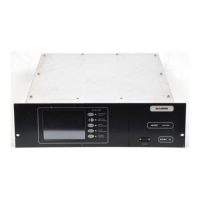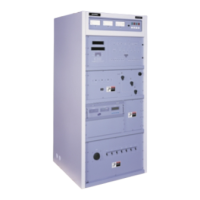SECTION C
POWER AMPLIFIER A1 through A4
C.1. Principles of Operation
Each PA board consists of four bridge
class D amplifiers with four power MOS-
FETS in a bridge or quad. The high side of
the PA is connected to the high voltage
power supply (260 volts) through jack J3.
The lowside ofeachPA quadisconnected
to the Modulator through jacks J11, J12,
J13, and J14. The PA is modulated by vary-
ing the PA voltage. The PDM modulator
system does this by pulling the low side of
the PA toward ground. The PA quads pro-
duce more output as the low side is pulled
toward ground.
TheRFdriveenterstheboardthroughjack
J2, and is relatively constant at all modula-
tion levels.
The following discusses the first quad-
bridge amplifier on the PA board and ap-
plies to the other three bridges since the
circuits are all identical. The series combi-
nation of R11 and L13 on one half and R12
and L16 on the other half, parallel resonate
the RF drive input.
To prevent the drive level from sagging
because of a failure in another quad, isola-
tion is provided by using separate drive
cables. For frequencies below 700 kHz, se-
rieschokesL14 andL15 are usedforfurther
isolation. Swamping resistors R13 and R14
areaddedforstabilityforfrequenciesbelow
1200 kHz.
260 volts DC is brought to the module on
J3 and is fed to each half of the quad via
fuses F11 and F12. RF chokes L11 and L12
are placed in series with the 260 volts to
allow only dc currents to flow in fuses F11
and F12.
Transistors Q11 and Q13 are driven 180
degrees out of phase with respect to transis-
torsQ12andQ14viatransformersT11and
T12. During one half of the RF cycle Q11
and Q13 are driven into saturation while
Q12 and Q14 are cutoff.
During the other half of the RF cycle Q12
and Q14 are driven into saturation while
Q11 and Q13 are in cutoff. This produces a
square wave voltage waveform of twice the
bridge voltage [jack J3 (260 volts) minus
jack J11 (modulator volts)] across the out-
put transformer on the PA Toroid Board.
Capacitors C11, C12, C13, and C14 RF
bypass the 260 volt supply on transistors
Q11 and Q14. Capacitors C16, C17, C18,
and C19 RF bypassthemodulator input and
alsoare the lastshuntcapacitorsinthe PDM
filter.
Diode CR13 prevents the modulator volt-
age from going below ground.
Blown fuses are detected via diodes CR11
and CR12.
C.2. PA Toroids
The PA Toroid boards combine the RF
power produced by the bridge amplifiers on
the PA boards. It makes connection to the
PA board at terminals E11 and E12 (bridge
amplifier 1).
Each transformer (T11, T21, T31, and
T41) carries the signal from the bridge am-
plifier tothe outputnetwork.Thesecondary
windings of transformers T11, T21, T31,
and T41 are in series such that the RF volt-
age across all of the transformers is
summed. The RF current in each toroid’s
secondary winding is equal.
One end of the secondary windings of A4
isconnected tocabinetgroundand theother
end of the secondary windings is connected
to A3, A3 to A2, A2 to A1. A1 is connected
tothe outputnetwork.Thus, thepowerfrom
each bridge amplifier is summed such that
at the end of the power combiner string the
transmitter’s output power is achieved.
C.3. Replacing a PA Module
Whenreplacing the PA module,besure an
even coating of thermal compound is ap-
plied to the mating heat sink surfaces. Be
certain to tighten downthe captivefasteners
which mount the PA module to the heat
sink. Be sure the RF drive cable J2 is fully
locked into position.
The toroids on the backside of the PA
should be inspected when the modules are
removed for replacing transistors. A crack
or break in any core may cause damage to
the transistors of the same quad. The best
way of inspecting the toroidal cores is by
rotating the core. This will allow a fairly
complete visual inspection.
C.4. Troubleshooting the PA Boards
C.4.1. Ohmmeter Testing
WARNING
REMOVE ALL PRIMARY POWER AND
DISCHARGE ALL HIGH VOLTAGE COM-
PONENTS WITH GROUNDING STICK BE-
FORE PERFORMING THE FOLLOWING
PROCEDURE.
All power MUST BE turned off for this
test.
The PA module can either be tested with
it in thetransmitter,butcanalsobe removed
from the transmitter for troubleshooting.
UsinganohmmeterontheRx1scale,
check the fuses on the PA module. Remove
ALL EIGHT fuses and discard any open
ones. A blown fuse usually indicates one or
two transistors have failed.
Use an ohmmeter on the Rx10k scale to
check the transistors.
NOTE
Determine which ohmmeter lead is posi-
tive in order to perform the following
troubleshooting procedure.
Connectthe positivelead oftheohmmeter
to the middle lead (drain)of a transistor
across from a fuse (transistors labeled with
an A in figure C-2). The negative lead
should be connected to the middle lead of
the nearest transistor across from a banana
jack (transistors labeled with a B in Figure
C-2). For a good transistor, the ohmmeter
will read greater than 700k. A shorted one
will read near zero the ohmmeter. The tran-
sistor which has beentested isthe one being
touched with the positive ohmmeter lead.
Connectthe positive ohmmeterlead to the
middle lead of a transistor labeled with a B
in figure C-2. Connect the negative lead to
the small banana jack located nearthat tran-
sistor (banana jacks are labeled with an C
in figure C-2). The ohmmeter will read near
700k ohms for a good transistor. A shorted
or leaky transistor will read substantially
lower. As before, the transistor being tested
is the one being touched with the positive
ohmmeter lead.
It is advisable to check all sixteen transis-
tors by the above procedure rather than test
only those associated with blown fuses.
Once familiar with the procedure, it will
only take a short period of time to check all
sixteen transistors. By checking all transis-
tors acomparisoncan alsobetaken between
pairs of transistors for future reference.
Before installing any replacements, refer
to the paragraphs on Handling MOSFETs
andTestingMOSFET’s.
Be sure to put all fuses back in place and
replace any open ones with an exact re-
placementbeforeturningon the transmitter.
Rev. AE: 03-05-2002 888-2314-001 C-1
WARNING: Disconnect primary power prior to servicing.
